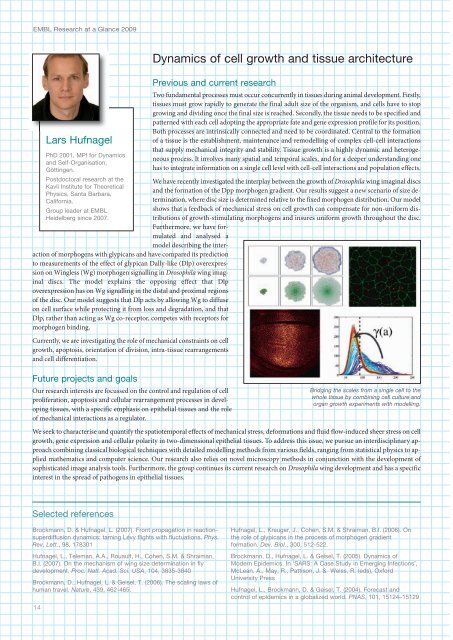Create successful ePaper yourself
Turn your PDF publications into a flip-book with our unique Google optimized e-Paper software.
<strong>EMBL</strong> Research at a Glance 2009<br />
Lars Hufnagel<br />
PhD 2001, MPI for Dynamics<br />
and Self-Organisation,<br />
Göttingen.<br />
Postdoctoral research at the<br />
Kavli Institute for Theoretical<br />
Physics, Santa Barbara,<br />
California.<br />
Group leader at <strong>EMBL</strong><br />
Heidelberg since 2007.<br />
Dynamics of cell growth and tissue architecture<br />
Previous and current research<br />
We have recently investigated the interplay between the growth of Drosophila wing imaginal discs<br />
and the formation of the Dpp morphogen gradient. Our results suggest a new scenario of size determination,<br />
where disc size is determined relative to the fixed morphogen distribution. Our model<br />
shows that a feedback of mechanical stress on cell growth can compensate for non-uniform distributions<br />
of growth-stimulating morphogens and insures uniform growth throughout the disc.<br />
Furthermore, we have formulated<br />
and analysed a<br />
model describing the interaction<br />
of morphogens with glypicans and have compared its prediction<br />
to measurements of the effect of glypican Dally-like (Dlp) overexpression<br />
on Wingless (Wg) morphogen signalling in Drosophila wing imaginal<br />
discs. The model explains the opposing effect that Dlp<br />
overexpression has on Wg signalling in the distal and proximal regions<br />
of the disc. Our model suggests that Dlp acts by allowing Wg to diffuse<br />
on cell surface while protecting it from loss and degradation, and that<br />
Dlp, rather than acting as Wg co-receptor, competes with receptors for<br />
morphogen binding.<br />
Currently, we are investigating the role of mechanical constraints on cell<br />
growth, apoptosis, orientation of division, intra-tissue rearrangements<br />
and cell differentiation.<br />
Future projects and goals<br />
Our research interests are focussed on the control and regulation of cell<br />
proliferation, apoptosis and cellular rearrangement processes in developing<br />
tissues, with a specific emphasis on epithelial tissues and the role<br />
of mechanical interactions as a regulator.<br />
Two fundamental processes must occur concurrently in tissues during animal development. Firstly,<br />
tissues must grow rapidly to generate the final adult size of the organism, and cells have to stop<br />
growing and dividing once the final size is reached. Secondly, the tissue needs to be specified and<br />
patterned with each cell adopting the appropriate fate and gene expression profile for its position.<br />
Both processes are intrinsically connected and need to be coordinated. Central to the formation<br />
of a tissue is the establishment, maintenance and remodelling of complex cell-cell interactions<br />
that supply mechanical integrity and stability. Tissue growth is a highly dynamic and heterogeneous<br />
process. It involves many spatial and temporal scales, and for a deeper understanding one<br />
has to integrate information on a single cell level with cell-cell interactions and population effects.<br />
Bridging the scales from a single cell to the<br />
whole tissue by combining cell culture and<br />
organ growth experiments with modelling.<br />
We seek to characterise and quantify the spatiotemporal effects of mechanical stress, deformations and fluid flow-induced sheer stress on cell<br />
growth, gene expression and cellular polarity in two-dimensional epithelial tissues. To address this issue, we pursue an interdisciplinary approach<br />
combining classical biological techniques with detailed modelling methods from various fields, ranging from statistical physics to applied<br />
mathematics and computer science. Our research also relies on novel microscopy methods in conjunction with the development of<br />
sophisticated image analysis tools. Furthermore, the group continues its current research on Drosophila wing development and has a specific<br />
interest in the spread of pathogens in epithelial tissues.<br />
Selected references<br />
Brockmann, D. & Hufnagel, L. (2007). Front propagation in reactionsuperdiffusion<br />
dynamics: taming Lévy flights with fluctuations. Phys.<br />
Rev. Lett., 98, 178301<br />
Hufnagel, L., Teleman, A.A., Rouault, H., Cohen, S.M. & Shraiman,<br />
B.I. (2007). On the mechanism of wing size determination in fly<br />
development. Proc. Natl. Acad. Sci. USA, 10, 3835-380<br />
Brockmann, D., Hufnagel, L. & Geisel, T. (2006). The scaling laws of<br />
human travel. Nature, 39, 62-65.<br />
1<br />
Hufnagel, L., Kreuger, J., Cohen, S.M. & Shraiman, B.I. (2006). On<br />
the role of glypicans in the process of morphogen gradient<br />
formation. Dev. Biol., 300, 512-522.<br />
Brockmann, D., Hufnagel, L. & Geisel, T. (2005). Dynamics of<br />
Modern Epidemics. In ‘SARS: A Case Study in Emerging Infections’,<br />
McLean, A., May, R., Pattison, J. & Weiss, R. (eds), Oxford<br />
University Press<br />
Hufnagel, L., Brockmann, D. & Geisel, T. (200). Forecast and<br />
control of epidemics in a globalized world. PNAS, 101, 1512–15129













